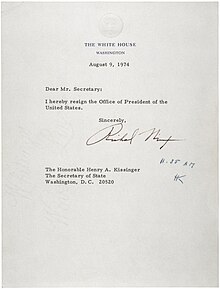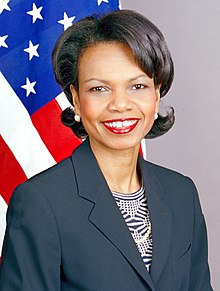United States Secretary of State
| United States Secretary of State | |
|---|---|
 Official Seal | |
since January 26, 2005 | |
| Appointer | President of the United States |
| Formation | April 6, 1789 |
| First holder | Thomas Jefferson |
| Succession | Fourth |
| Website | www.state.gov |
The United States Secretary of State (commonly abbreviated as SecState) is the head of the United States Department of State, concerned with foreign affairs. The Secretary is a member of the President's Cabinet and the highest-ranking cabinet secretary both in line of succession and order of precedence.
History
On January 10, 1780, the Second Continental Congress created the Department of Foreign Affairs.[1] On July 27, 1789, George Washington signed a congressional bill into law reauthorizing an executive Department of Foreign Affairs headed by a Secretary of Foreign Affairs. Congress then passed another law giving certain additional domestic responsibilities to the new Department and changing its name to the Department of State and the name of head of the department to the Secretary of State, and Washington approved this act on September 15, 1789. The new domestic duties assigned to the newly renamed department were receipt, publication, distribution, and preservation of laws of the United States, custody of the Great Seal of the United States, authentication of copies and preparation of commissions of executive branch appointments, and finally custody of the books, papers, and records of the Continental Congress including the Constitution itself and the Declaration of Independence.
The title of Secretary of State is British in origin. At the time of American independence, Britain had two secretaries of state. Both dealt with domestic affairs, but divided foreign affairs based on whether the country was Catholic or Protestant. By the end of the American Revolution, they were reorganized such that there was a Secretary of State for Home Affairs and Secretary of State for Foreign Affairs. Thus, when the U.S. Secretary of Foreign Affairs was given domestic responsibilities, "Secretary of State" made sense in the historical context as the new name for the officer.
Particularly in the early years of the republic, the post was regarded as a natural stepping-stone to the Presidency. Secretaries of State who later occupied the White House included Thomas Jefferson, James Madison, James Monroe, John Quincy Adams, Martin Van Buren and James Buchanan. Secretaries who unsuccessfully ran for President (either before or after their service at the State Department) were Henry Clay, Daniel Webster, John C. Calhoun, William H. Seward, James G. Blaine, Walter Q. Gresham, John Sherman, Elihu Root, William Jennings Bryan, Charles Evans Hughes and Edmund Muskie.
Functions

Most of the non-original domestic functions of the Department of State have been transferred to other agencies. Those that remain include storage and use of the Great Seal of the United States, performance of protocol functions for the White House, drafting of proclamations, and replies to inquiries. In accordance with the United States Constitution, the Secretary performs such duties as the President requires. These include negotiating with foreign representatives and instructing U.S. embassies or consulates abroad. The Secretary also serves as a principal adviser to the President in the determination of U.S. foreign policy and, in recent decades, has become responsible for overall direction, coordination, and supervision of interdepartmental activities of the U.S. Government overseas, excepting certain military activities.
As the highest-ranking member of the cabinet, the Secretary of State is fourth in line to succeed the Presidency, coming after the Vice President, the Speaker of the House of Representatives, and the President pro tempore of the Senate. (See United States presidential line of succession.)
Federal law (3 U.S.C. § 20) provides that a presidential resignation must be accomplished by written communication from the President to the Secretary of State. This has occurred once, when President Richard Nixon resigned in August 1974 via a letter to Secretary of State Henry Kissinger.
When there is a vacancy as Secretary, the office is exercised by another member of the cabinet, as was common in earlier history, or, in more recent times, by a subaltern official of the State Department until the President appoints and the United States Senate confirms a new Secretary.
List of Secretaries of State
References
- General
- "Secretaries of State, 1791-2005". United States Department of State. 2005. Retrieved 2006-04-09.
- Specific
- ^ "Intelligence & the War on Independence: Organization of Intelligence". Central Intelligence Agency. 2008-05-01. Retrieved 2008-06-12.



